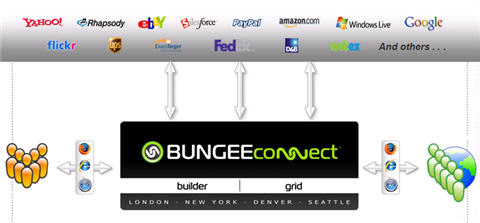Bungee Labs opens developer platform-as-a-service

Bungee Labs launched a public beta of a new version of its BungeeConnect, an on demand application development platform for professional programmers. The concept is similar to what salesforce.com is doing with its Force.com platform, although Bungee Labs claims that it is differentiated on the basis of being purely cloud based.
"Salesforce.com is 'runtime-as-a-service,' " said Lyle Ball, vice president of marketing at Bungee Labs. "It requires an Eclipse plug-in for working offline and then testing and deploying in the salesforce cloud." The purity argument won't resonate with salesforce.com developers who want to take advantage of its extensive ecosystem.
Bungee Labs defines platform-as-a-service as a single environment for delivering the entire software lifecycle as a service to increase productivity, shorten time-to-market and reduce overall costs for enterprise-class applications.
BungeeConnect eliminates the cost of maintaining separate environments for building, configuring, testing and deploying applications, Ball said. He claimed that in private beta testing users built and deployed applications in one-fifth the time in comparison to conventional on-premises solutions.
BungeeConnect includes the usual tools and visual user interface layout components. It also has its own language, BungeeLogic, which is based on C. The company has built data centers Xen-virtualized Linux servers in Denver, New York and London for its multitenant grid. Each application section is running on its own process on the server, according to Brad Hintze, director of product marketing. Amazon EC2 is used as a back up in case its own data centers fail.
The application builder has facilities for source code control, versioning, collaborative development, auditing, application performance management, testing, staging, rollout and roll-back.
Pricing is based on a combination of network bandwidth usage, server CPU time and server memory footprint. Developing and testing are free--users only pay for applications in use. The company is working a definition for a $1 Bungee unit and in the process of building its billing application, Hintze said. He gave an example of a heavily used calendar application, called WideLens and built by Bungee Labs, that integrates data from Google, salesforce.com, Microsoft Exchange and its own application and would cost $2 to $5 per user per month.
I asked about offline access for BungeeConnect. "Offline access has been a high discussion point. Developers told us that if they are building lives apps that interact with services they couldn't imagine why they would want to develop offline," said Ball.
The company has received an undisclosed amount of funding from North Bridge Venture Partners, Venrock Associates, and Epic Ventures (formerly Wasatch Venture Fund). "We are a long term play. We are pacing ourselves in a strategic and gated way," Ball said.
I asked Michael Cote of Redmonk for his expert take on BungeeConnect after he was briefed on the product:
Without a doubt, the idea of "mashup server" (a phrase Bungee deftly avoided using [with me at least] except one passing mention) or whatever you want to call the return of Rapid Application Development platforms is something that development shops are hungering for now in the face of public web companies that cream corporate development in innovation and sexy software.
There's a bit of trail-blazer/IT reality mismatch, but if Bungee can get some big, boring enterprises on as early customers and address those enterprises' (from the perspective of Web 2.0) "backward" notions about things like security, openness, project management and auditing, they'll have something interesting. As an example, the amount in and detail of logs looks promising. With a little bit of UI and enterprise process work, a sort of "Bungee IT Dashboard" would make audit-data starved IT departments salivate at the application centric monitoring they could do.
As it stands, Bungee would need some old school enterprise partner(s) to get beyond the "what the hell is this new fangled thing?" reaction they'll encounter when introducing a public-Web hosted development platform to corporate managers. I don't really know if a whole new programming language thing will fly. It will be interesting to see how well salesforce.com's custom language has fared, and hopefully Bungee will put in "bridges" for at least one other, existing language. Otherwise, "learn a whole new programming language" is going to be tough when going up against people, for example, like WaveMaker who'll let you fall back on Java.
